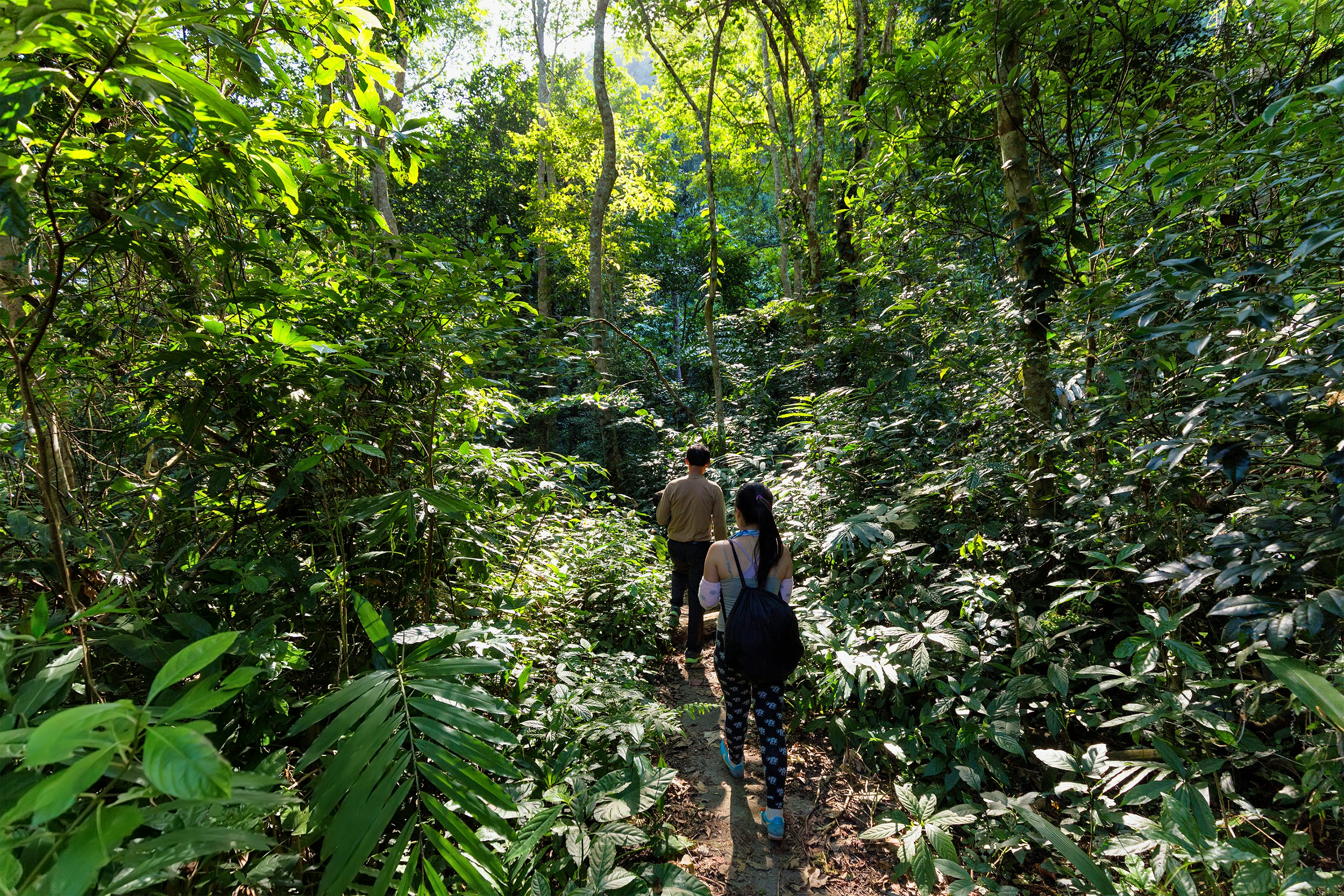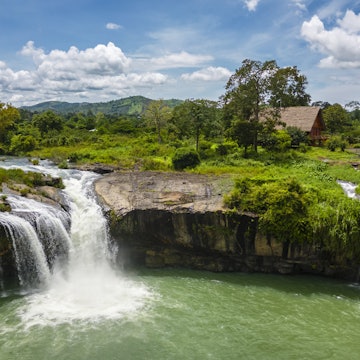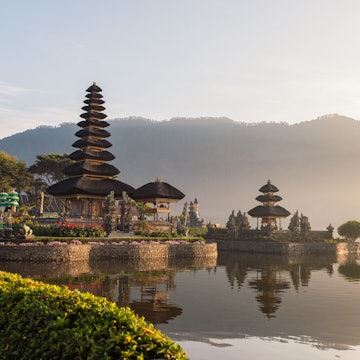

Fansipan, Vietnam's tallest mountain. Rbentley1294/Shutterstock
Modern Vietnam is a million miles from its war-torn past.
Jungle-cloaked hills that once shook with the sound of combat are now the serene setting for adventurous hikes to remote villages, lofty lookouts, tumbling waterfalls and the summit of Indochina’s highest mountain. With plenty of local guides and trekking agencies on hand to help you to the top of the trails, all you really need to do is pick a route – and set out.
Many of Vietnam’s top hikes are best attempted with local support. The tropical terrain can be challenging, the weather can be unpredictable, and you’ll need someone who speaks the local languages to make arrangements for meals and accommodation in hill-tribe communities. If you combine a trek with a village homestay – which we heartily recommend – it’s possible to escape the crowds and find the hospitality and captivating culture that first put Vietnam on the travel map.
With its towering topography, the mountainous north of the country offers the best trekking opportunities; however, there are routes available throughout the country, ranging from the Chinese border to the lowland jungles near Ho Chi Minh City. Here’s our pick of the top treks in Vietnam.
1. Cultural treks from Sapa
Easiest hikes for beginners
Distances vary, 1–2 days, easy
Hill-tribe treks from Sapa are a core part of the tourist experience in northern Vietnam, and hiking here is now quite mainstream. Still, there are rewarding experiences to be had if you go with a guide who speaks the languages of local minority groups and can introduce you to the diverse communities that French colonizers grouped under the umbrella term Montagnards (mountain dwellers).
Don’t expect to get too far off the beaten track – the most popular villages have entry fees, souvenir shops and a rather entrepreneurial attitude toward tourism. Favor treks to Sin Chai, Cat Cat, Ban Ho and Y Linh Ho, which will take you away from the heaviest crowds. For a more authentic experience, consider trekking over two days with an overnight stop at a local homestay, or save your trekking for a more remote location, such as Bac Ha or Ba Be National Park.
2. Tribal treks around Bac Ha
Best treks for tribal encounters
7–10km, 1–3 days, easy to moderate
How Bac Ha slipped under the radar as a trekking base is a mystery: the village remains a charmingly unspoiled hub for hikes to the villages of 11 tribal groups, including the Flower Hmong, Dzao, Giay, Han, Xa Fang, Lachi, Nung, Phula, Tay, Thai and Thulao. To truly experience local life, consider going with a local guide and staying overnight in villages nestled in the emerald hills.
For an easy day hike, try the 8km hike through the Flower Hmong village of Thai Giang Pho to the Tay village of Na Lo, passing some of the finest rural scenery anywhere in northern Vietnam. For a great overnight route, test your legs on the 10km hike through rice paddies, cinnamon forests and misty hills to the Dzao villages of Nam Det and Nam Khanh.
Wherever you trek, aim to be back in Bac Ha by the weekend: the Sunday market in Bac Ha and the Saturday market in nearby Can Cau both draw tribal people from across the region. There are also markets in the villages of Coc Ly, Lung Phin and Sin Cheng.

3. Fansipan
Best mountain trek
9–20km, 1–3 days, moderate to difficult
At 3147m, Vietnam’s highest mountain presents a satisfying challenge – though the paths are rough and regular rain means the going can be slippery underfoot. As you climb the slopes of Fansipan, expect adrenaline-inducing scrambles up steep slopes and gasp-producing views across the Hoang Lien Mountains (Tonkinese Alps) when the clouds clear.
The summit of the mountain, known as the “roof of Indochina,” is most easily reached from the Tram Ton pass on the northern side of the mountain, accessible by local bus from Sapa. There are also challenging alternative trails starting from the villages of Cat Cat and Sin Chai that require camping for one or two nights.
Guides are mandatory – and sensible in this rugged terrain – though some travelers sneak up the trails unaccompanied. Fit trekkers can tackle the Tram Ton trail in a day, returning via the cable car across the Muong Hoa Valley. Most people cover the ascent over two or three days, camping at rustic sites along the way. With scenery so lovely, why rush the journey?
4. Ba Be National Park
Best treks for escaping the crowds
Distances vary, from 1 day, moderate
Lush, green Ba Be National Park offers everything you could ask for from the Vietnamese highlands: limestone peaks climbing out of misty valleys lined with ribbon-like lakes, dense jungles hiding myriad bird, mammal, and butterfly species, and a dozen villages populated by the Tay, Dzao and Hmong communities. Ba Be is still largely undiscovered by the masses, even if word is slowly getting out.
Treks here are as they were in Sapa a generation ago, offering a deep dive into mountain culture and a way of life that still moves in sync with the rhythms of the seasons. As well as sampling village life, you can drop in on dramatic waterfalls and tortuous cave systems, and stop overnight at quiet homestays overlooking the lakes.

5. Cat Ba National Park
Best island adventure trek
Distances vary, 1–2 days, moderate
The scenery in Cat Ba National Park in Halong Bay appears almost impossibly green, with moss beds and forest glades showing a range of emerald, lime, chartreuse and other shades. This vibrant landscape is best experienced on foot, starting from the park headquarters at Trung Trang. While guides are not required, they can help you get closer to the wildlife: be sure to watch for golden-headed langurs, the world’s most endangered primate.
The “easy” option here is the short, strenuous hike to the top of Ngu Lam peak, a modest ridge offering views over the surrounding jungle, though many choose the more challenging 9km hike across the park to the fishing village of Viet Hai, where you can stay at a friendly homestay. The park is also a popular spot for climbing, with several operators offering trips to local karst outcrops that include all necessary gear.

6. Nam Cat Tien National Park
Best trek in southern Vietnam
2–26km, 1–3 days, moderate to difficult
The south of Vietnam is often overlooked by trekkers. Don’t make that mistake.
Cat Tien National Park spans 72,000 hectares of tropical lowland rainforest rich in biodiversity. While elephants and leopards may be hidden in the foliage, you’re more likely to see primates like gibbons, pygmy lorises and langurs, along with reptiles, amphibians and countless bird species.
Guides can be arranged through local lodges. The most popular trip is the half-day hike from the national park headquarters in search of golden-cheeked gibbons, though this involves an early start to catch the primates’ hooting dawn chorus. Most trekkers visit the Dao Tien Endangered Primate Species Centre for more simian encounters; trip fees help fund the park’s conservation efforts.
7. Mai Chau villages
Best easy hikes near Hanoi
5–18km, 1–2 days, easy
You don’t have to roam far from Hanoi to find good hiking terrain. The township of Mai Chau floats on a green carpet of rice fields, about 135km southwest of the capital. This area offers pretty rather than tough terrain, with the most popular walking destinations being villages inhabited by the White Thai. These residents are known for their vibrant textiles, which can be purchased without much bargaining.
For a taste of what the area offers, try the 18km trek from Ban Lac village to Xa Linh village. A local guide will help you navigate the slippery trail, and you’ll need to arrange transportation to pick you up at the end of the trail for the trip back to Mai Chau. Longer hikes can be booked through local homestays and lodges, though we recommend visiting during the week to avoid weekend crowds.
8. Cao Bang
Best off-the-beaten-track treks
Distances and durations vary, moderate to difficult
Tucked away near the Chinese border in the far northeast of Vietnam, Cao Bang is the place to discover rural communities that have mostly avoided the effects of mass tourism. This comes with some responsibility, so make sure to hike with a guide and stay in village homestays to ensure your tourist dollars support the local economy. The main destinations for hikers are hillside villages of the Tay, Nung, Hmong, Dzao and Lolo peoples, with markets that shift from village to village on different days of the lunar month.
There are easy strolls around Ban Gioc Waterfall and Nguom Ngao Cave – both served by local buses from Cao Bang – but to access outlying villages, you’ll need local support. Most treks are multi-day affairs, and your guide will need to make arrangements for overnight stays. It may be easiest to organize a trek through a reputable agency in Hanoi.
















